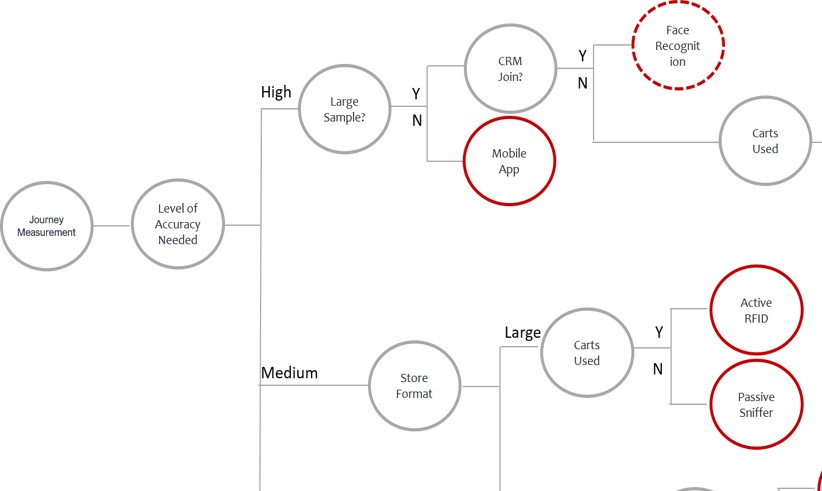An In-Store Shopper Measurement Technology Decision-Tree
An In-Store Shopper Measurement Technology Decision-Tree
By Gary Angel
|October 25, 2018

Making the Right Choice for Measurement Store Traffic and Shopper Journey
My last post described how store format impacts shopper measurement tracking technology decisions. Why is store format so important? It impacts a bunch of factors, from use-case to likelihood of carting – but it’s really positional accuracy and cost that drive a lot of the decision. The investment in technology required to cover a large format store can be daunting and it’s often hard to justify the measurement spend. On the other hand, large format stores can often work with geo-location data that is significantly less precise when it comes to positional accuracy. In a 100K square foot store, a couple of meters rarely makes a difference in understanding the customer journey. In a 1000 square foot, three meters often spans two areas. The implications are big because in the world of geo-location technology, the primary tradeoffs in technology tend to be between positional accuracy and cost.
But store format isn’t the only driver of measurement technology. When we work with clients to choose a measurement technology, we use a kind of decision tree (that’s grown over time and keeps getting more and more complex) that helps clients think through what technology is right for their use-cases.
In this post, I’ve only included the decision tree for companies interested in Journey Measurement. If your use-cases are focused on door counting, queue measurement, attribution, pass-by traffic, high-level store performance or in-store marketing, well…there’s a decision tree for that too.
To use the tree, you need to understand each of the decision factors. Here’s a quick description of each.
Positional Accuracy
If you need to get accuracy at the meter or less level, your technology options are very much reduced – and it doesn’t much matter what store-size you have. For applications with less demanding standards, additional technology options and considerations come into play. We think of Medium accuracy as living in the 2-8 meter range. Low accuracy is typically in the 8-10 meter range. I’m aware that the range of accuracy cited for medium is quite large. However, that’s not as bad as you might expect. The technologies here can all deliver 2M performance if carefully deployed – it’s just that the alternative technologies (Wiif) used in Low accuracy cases can’t really do better than about 8M.
Large Sample
Not every measurement application demands a large sample. If you want to look at average line times, being able to measure 10% of your population may be enough (and it doesn’t even need to be a particularly representative sample). For most journey measurement analyses, though, you’ll want a fairly substantial portion of the shopper population.
CRM Join
If your primary use-case requires joining data to the rest of the shopper’s record, you need to find a technology that allows you to do that. There aren’t that many options – so if this is your use-case, at least your decision will be easy!
Carts Used
Why do carts make a difference? You can use passive shopper tracking technologies (like camera) in any kind of store. But if you happen to have carts or baskets, you can attach Active RFID tags to them and have a very low impact, no privacy issues, pretty darn accurate tracking solution. Since you can’t (in most cases) slap an active RFID tag on a shopper, that technology choice is limited to cart-based environments.
Store Format / Size
Yes, size does matter. No factor likely has a bigger impact on the technology decision you make. Because each technology has radically different cost and coverage characteristics (not to mention positional accuracy and journey tracking capabilities), size will often dictate what’s practical from a cost perspective and what’s efficient from a measurement perspective. Typically, size is closely (and inversely) related to requirements for positional accuracy. Large stores have bigger departments and less need to track very fine-grained areas.
Variable Fleet
This one’s a little bit ambiguous. The basic idea is that if you need to cover a wide range of formats that vary in size, you probably need a single technology that’s fairly adaptable across footprints. Not every format is equally adaptable so if you want consistency of measurement collection you might sacrifice some small format capabilities to get something that is practical in all your stores.
Willing to Install
Installation is one of the real pain points in store tracking technology. Nobody likes to do installs and the process is fraught with pain and problems. For small stores, though, there’s the additional fact that the cost of installation often exceeds the cost of the hardware. That can make measurement seem prohibitively expensive. If the cost of professional installation is a problem, a solution that makes self-install easy becomes paramount.
The bottom line is that it’s not so easy to choose the right technology for in-store shopper measurement and geo-location tracking. Every technology out there has multiple pain points and regularly drives us crazy. Cost, positional accuracy, coverage, sample-size, and ease of installation not only vary wildly, but will often prove critical for specific situations and types of stores. No simple decision tree is going to capture every aspect of your situation, but I hope this one at least gets you looking in the right direction and thinking about the right kinds of questions!
If you want to see how all of these technologies fit in with the world’s most powerful shopper measurement analytics platform, drop us a line!
